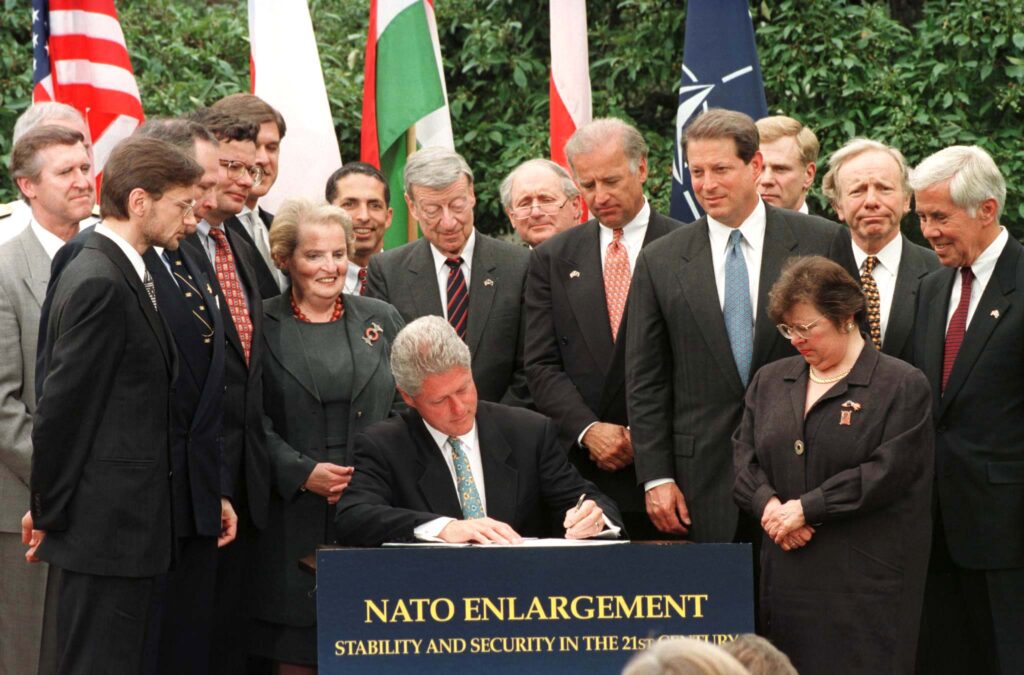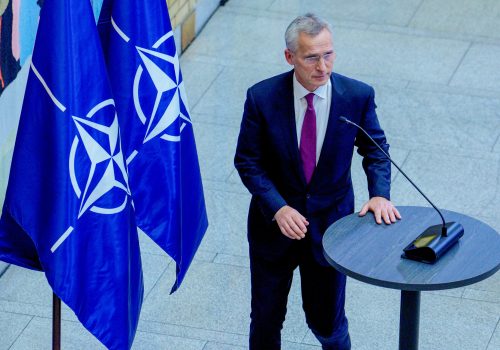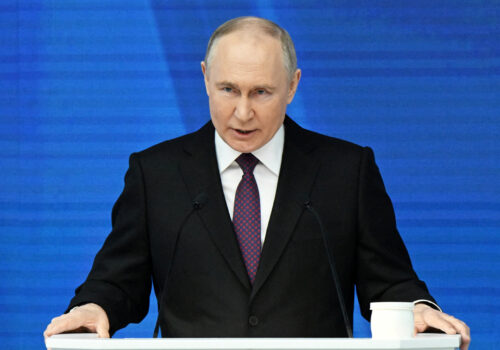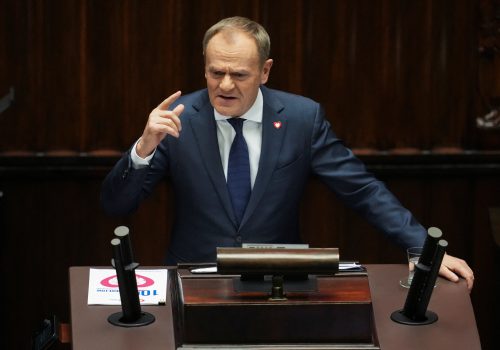Two years ago, Russian President Vladimir Putin launched a full-scale war to force Ukraine back into Russia’s empire. Other European nations once under Kremlin control escaped that fate, arguably because they were already NATO members. This coming Tuesday, March 12, marks the twenty-fifth anniversary of NATO’s enlargement to include Poland, the Czech Republic, and Hungary, which paved the way for others in formally Kremlin-dominated Europe to do so and later to join the European Union (EU). NATO enlargement seems, then, to have been a big success. But critics have blamed NATO enlargement for alienating Russia or for encroaching on Russia’s natural “sphere of influence.”
Why did NATO decide to bring in countries that had just escaped Moscow’s control? What was the United States seeking? What were the Poles and others in Central and Eastern Europe after? Did the policy discount the risks or ignore Russian interests? The authors of this article, a Pole and an American, played roles in their respective governments in the 1990s and worked closely together on NATO enlargement. Given the persistent argument over the merits of NATO enlargement, the debates from that time are still relevant today.
Removing the Iron Curtain
The Poles, like many others in Central and Eastern Europe, had concluded in the early 1990s that their newly regained freedom would be at risk without membership in NATO. They thought that the West, the United States especially, had a window of opportunity to act. Lech Wałęsa and Václav Havel, leaders respectively of Poland’s and the Czech Republic’s successful efforts to overthrow communism in 1989 and then presidents of their countries, conveyed this message to US President Bill Clinton in the early months of his presidency.
The Clinton administration understood the Poles’ and others’ fears and aspirations but initially prioritized relations with Russia and opposed NATO enlargement. If post-Soviet Russia developed in a democratic and pro-Western direction, went the initial US logic, then European security, Central Europe’s included, would follow.
US administration thinking changed, however, after serious (and sometimes contentious) internal debate. National Security Advisor Anthony Lake especially grew uncomfortable with a policy that would lock Central Europeans outside Western institutions and leave them in a “gray zone.” Treating the Central Europeans as apart from the rest of Europe would, he and some others in the Clinton administration feared, effectively perpetuate the line of the Iron Curtain, leaving them subject to future Russian domination. Moreover, by 1993, free market democracy in Central Europe, especially in Poland, was advancing, producing what would become a generation of mostly rapid growth and political stability while in Russia, reforms were uneven and nationalist parties were rising as early as 1993. Given the reality on the ground, a design for post-Cold War European and transatlantic security based solely on hopes for Russia seemed shaky.
The Clinton administration concluded that achieving a Europe whole and free required erasing the line of the Iron Curtain. That meant opening the West’s key institutions, starting with NATO and the European Community (now the EU) to the Central Europeans if they met Western standards in key areas such as democracy, free markets, and good relations with their neighbors.
A two-track approach
The United States did not cast aside relations with Russia. NATO enlargement would be part of a two-track approach, proceeding in parallel with development of a NATO-Russia relationship that could become an “alliance with the Alliance.” NATO enlargement and NATO-Russia relations would not be linked. Each would proceed independent of progress on the other, meaning that Russia could not block NATO enlargement by stalling on NATO-Russia relations.
The Clinton administration also addressed Russian concerns about the military implications of NATO enlargement, including two key assurances in the 1997 Founding Act that formalized the new NATO-Russia relationship. First, the Founding Act affirmed that NATO had “no intention, no plan, and no reason to deploy nuclear weapons on the territory of new members.” Second, the Alliance declared that “in the current and foreseeable security environment,” NATO defense did not require the “additional permanent stationing of substantial combat forces.” NATO kept these pledges, even after Russia’s invasions of Georgia in 2008 and Ukraine in 2014. Moreover, the United States continued its post-Cold War drawdown of its forces in Europe.
The Poles remained skeptical about Russia’s post-Soviet development, but they accepted the Clinton administration’s two-track approach, especially given US assurances that NATO enlargement would be based on the ability of Poland and other aspirants to meet NATO’s standards, not on Russia’s permission. To support the Clinton administration’s case, the Poles even toned down their public skepticism about Russia, emphasizing that NATO enlargement aimed more at integrating and stabilizing Europe than warding off a potential Russian threat.
The Poles worried that NATO would offer only second-class membership, with caveats that would weaken the Article 5 collective defense commitment. But the United States informally consulted with the Poles about the wording of the Founding Act’s assurances to Russia about conventional force stationing, explaining what it did and did not mean, and took Polish concerns into account before finalizing the language.
In 1997, NATO advanced the NATO-Russia relationship by concluding the Founding Act and, later that year at the Madrid NATO Summit, extended an invitation to Poland, the Czech Republic, and Hungary. The US Senate ratified their accession to the Alliance in 1998 (by a strong vote of 80-19) and on March 12, 1999, NATO formally brought in the first countries that had been east of the Iron Curtain. The George W. Bush administration continued the two-track policy. NATO upgraded the NATO-Russia relationship in 2002 and, later that year, NATO extended invitations to seven more Central and Eastern European countries, including Estonia, Latvia, and Lithuania, all of which had been illegally annexed by the Soviet Union in 1940. In 2004, all of these new NATO members also joined the EU.
A NATO enlargement balance sheet
What is the net result of NATO enlargement twenty-five years after the accession of Poland, Hungary, and the Czech Republic?
NATO enlargement met its objectives. Most Central European countries, comprising more than one hundred million people, enjoyed a generation of economic development, democracy, and security that few on either side of the Iron Curtain expected when the Berlin Wall fell in 1989.
The NATO-Russia track did not. Russian President Boris Yeltsin de facto accepted NATO enlargement in 1997 and Putin, who succeeded Yeltsin in 2000, did not object to enlargement, even to the Baltic states. But several years into his rule, Putin turned to authoritarianism at home and increased his ambitions abroad, trying, as later became apparent, to reassemble the Russian empire, including through war. He mistakenly saw a US hand in indigenous pro-democracy movements that backed pro-Western leaders in Georgia and Ukraine. By 2007, Putin had cast the West as a foe.
Nevertheless, NATO enlargement appears even better in hindsight. In 1993-94, Wałęsa and Havel cautioned Clinton that if NATO did not bring in new members when it could, Russia would return to claim as much of its former empire as its armies could reach. The war they warned about then is the war Ukraine now faces: a war of imperial reconquest. Putin has repeatedly made clear his support for Russia’s imperial ambitions as well as his contempt for Poland and his endorsement of false narratives about Poland’s history, including in his most recent interview with Tucker Carlson. If NATO enlargement had not taken place, then Europe might now be dealing with Russian domination of Ukraine, reoccupation of the Baltics, and the direct threat of an invasion of Poland.
What went wrong in relations with Russia was not NATO enlargement but Russian leadership’s own conception of their country and its needs. The United States sought to work with post-Soviet Russia as a country. Putin came to define Russia as an empire. Those imperial claims include Ukraine and potentially extend to the Baltic states, Poland, Finland, Moldova, Georgia, Armenia, Azerbaijan, and most of Central Asia. As a giant billboard in Russia, including at the border with Estonia, puts it, “Russia’s borders do not end.” NATO enlargement did not prevent Russia from launching imperial wars. It did make sure that those wars took place further east.
To mark the anniversary of Poland’s NATO membership, Polish President Andrzej Duda and Polish Prime Minister Donald Tusk will meet with US President Joe Biden on March 12 in Washington. These Polish leaders come from different and competing ends of Poland’s political spectrum, but they are united in their support for NATO, for Ukraine, and for the free world. They have an opportunity on this anniversary to stress how much Europe and the United States gained over the past generation as freedom and security advanced and how critical it is to continue that process by supporting Ukraine in its fight for those same values.
Jerzy Koźmiński was director general and undersecretary of state in the Polish Prime Minister’s Office from 1989-1993, Poland’s deputy foreign minister from 1993 to 1994 and Poland’s ambassador to the United States from 1994 to 2000. Currently he is president of the Polish-American Freedom Foundation.
Daniel Fried is the Weiser Family distinguished fellow at the Atlantic Council and former US ambassador to Poland. 2000. He was a political counselor at the US Embassy in Warsaw from 1990 to 1993, national security director and later senior director for Central and Eastern Europe from 1993 to 2000, and US ambassador to Poland from 1997 to 2000.
Further reading
Mon, Nov 6, 2023
How to keep NATO relevant into 2024 and beyond
New Atlanticist By Giedrimas Jeglinskas, Zelma Sergejeva
As the 2024 Washington Summit gets closer, allies should stand up for freedom, ensure continuous support to Ukraine, and credibly boost their defense spending and capabilities.
Tue, Mar 5, 2024
Putin is on an historic mission and will not stop until he is finally defeated
UkraineAlert By Peter Dickinson
Vladimir Putin believes he is on an historic mission to reclaim "Russian lands" and will inevitably go further if he is not stopped in Ukraine, writes Peter Dickinson.
Tue, Dec 12, 2023
New Polish PM Donald Tusk vows “full mobilization” of West to help Ukraine
UkraineAlert By Peter Dickinson
Poland’s newly appointed Prime Minister Donald Tusk has vowed to rally Western support for Ukraine as it continues to defend itself against Russia’s ongoing invasion, writes Peter Dickinson.
Image: President Clinton signs a document formally notifying NATO that the U.S. has approved its three-nation expansion as members of his cabinet and Congress look on in the Rose Garden of the White House May 21. The United States was the fifth of the 16 alliance countries to approve the admission of Poland, Hungary and the Czech Republic into the NATO alliance. Photo by Robert Giroux.



